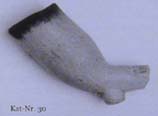No. 14/2001, p. 4-7
Ralf Kluttig-Altmann: Report on the 14th Meeting of the German
Society for Clay-Pipe Research held on 1- 4 June 2000 in Liestal,
Switzerland
The Society was invited to hold their meeting in Liestal by the
Archaeological section and Museum of the Canton of Basel Land. Sixteen
members from Germany, Holland, and Switzerland attended. M. Schmaedecke,
the organiser of the meeting, gave an account of the use of clay
pipes in Switzerland as well as his ideas on the typology of floral
decorations on 17th century pipe stems. K. Rudin reported on finds
of Gambier pipes, and M. Weidner on clay pipes from the River Elbe.
R. Articus gave a historical review of clay-pipe research, and R.
Stamm interpreted political motifs on clay pipes. R. Klutttig-Altmann
reported on the results of his work on systematic typology of rolled-on
stem decorations. M. Kügler described a mould for a pope bowl
dated between 1619 and 1622 found in Heidelberg.
- more -

|
|
|


Pipe mould, outside (top) with "IA" or "JA"
scratched on, and inside (bottom)
|
No. 14/2001, p. 9-13
Martin Kügler: A mould for clay pipes? Comments on a find
in Heidelberg
The author gives his interpretation of the purpose of a small mould
with a hollow to fit one half of a pipe bowl, which was found during
excavations in 1986/87 at No. 74 Untere Neckarstrasse in Heidelberg.
The mould could not have served to make a real pipe bowl of a smokable
pipe, but for a solid object shaped like a pipe bowl. This object
might have been part of a larger model. The other finds in the assemblage
indicate that the mould was made and used in 1619 by Joost Affsers,
a potter and glazed-brick stove builder. The shape of the pipe bowl
and the decoration engraved in it are similar to those on pipes
from England and the Netherlands made in this period.

|
|
|

Pipe with heel but with no decoration or mark,
late 17th century
|
No. 14/2001, p. 13-20
Helmut Szill: Clay pipes from Erding. Part I
In almost 20 years of collecting on fields around Erding, the author
has found almost 4000 clay-pipe fragments, about 80% of which date
from the mid to late 17th century. There is as yet no evidence for
the existence of a regionally important clay-pipe industry in what
is now the State of Bavaria in this period. Thus, it is not impossible
that clay pipes were imported from the Netherlands. The provenance
of these rather roughly made pipes is therefore still matter of conjecture.
In Part I of this paper an account is given of the historical background
to the occurrence of large quantities of clay pipes in Erding. Then
three of the eleven groups of clay-pipe fragments are dealt with.
These finds show a close resemblance to the clay-pipe assemblages
found in Passau and in the Salzburg Land, which have already been
described. In Part II of the paper clay-pipe fragments with relief
decoration and those bearing the maker's initials are dealt with.

|
|
|
No. 14/2001, p. 20-26
Herbert Böhmer: Documentary evidence on clay-pipe makers
in Passau
Archives research has enabled the author to identify three clay-pipe
makers in the Ilzstadt district of Passau and to locate where they
lived. From this information it is clear that clay-pipe manufacture
was begun in Passau in 1716 by Johann Stiegler (active until 1738).
Other clay-pipe makers were Johann Geissler (1723-1777) and Johann
Kollmann (1777-1800?). Although we know where these men lived, no
clay-pipe fragments have yet been found at these sites. However,
finds at another potter's house can be associated with one of the
above clay-pipe makers. It is surprising that this study has not
helped to identify any Passau clay-pipe maker's products amongst
the rich finds from the Veste Oberhaus.
|
Part of bowl and stem of a green-glazed pipe,
end of 17th century
|
 |

|
|
|

Fragment of pipe stem with floral decoration, provenance
unknown, around 1700
|
No. 14/2001, p. 26-31
Rüdiger Articus: Clay-pipe finds from the Mellingburg wier
on the River Alster
Clay-pipe fragments picked up in the area around the former Mellingburg
wier are 18th century products, which show a wide range of provenance.
Many originate from the Netherlands, and others from Altona, Itzehoe
(?), Uslar, Grossalmerode, Walbeck and Holzminden (?).

|
|
No. 14/2001, p. 32-49
Ralf Kluttig-Altmann: Observations on the roll-on technique used
for pipe-stem decoration. With a contribution from Martin Kügler
Our work on the typology of manually rolled-on decoration on pipe
stems has shown that it is essential to first have a detailed knowledge
of the techniques used to produce this decoration by means of a
die, a roll-on die, etc. Historical technological descriptions tend
to provide hardly any details of this aspect of clay-pipe production,
or the descriptions are just incorrect. Tools for this purpose are
very rarely preserved. Thus, the only way of obtaining information
about the methods and the tools used is to make very detailed observations
on the clay-pipe stems themselves. Many of the pipe-stem decorations
are figured to help readers to classify their own material.
|
|
Tool for impressing decoration on pipe stem, Hilgert, Westerwald
|

|
|
|

Portrait pipe of Abd el-Kadir, made by Blanc Garin,
Givet, around 1850
|
No. 14/2001, p. 50-53
Ruud Stam: Clay pipes and politics: the importance of the political
pipe in the 19th century
The author shows how often throughout the whole period during which
clay pipes were smoked (17th to 20th centuries) a smoker could demonstrate
his political affinity by means of a special motif on his clay pipe.
The acme of this type of political identification was during the second
half of the 19th century, when no longer only well known historical
figures but also contemporary monarchs and politicians were increasingly
portrayed on pipes. These pipes portraying people mostly came from
France (the firm of Gambier) but were copied in Gouda although in
insufficient quantity to meet demand. Although there were other every-day
objects on which certain personalities or slogans could be portrayed,
the political pipe, as a common mass-produced article, occupied an
important place in 19th century political life, an almost exclusively
masculine world.

|
|
No. 14/2001, p. 53-60
Walter Morgenroth: The secret of the genuine Schemnitz tobacco
pipes
|
Pipes manufactured in the clay-pipe making town of Schemnitz
(Banská Štiavnica) in Slovakia had a characteristically
narrow cylindrical bowl and enjoyed considerable popularity
in the 19th century and at the beginning of the 20th century.
These pipes were copied in many places and called Schemnitz
pipes. As a consequence it is very difficult to distinguish
a genuine Schemnitz pipe from a copy. The author provides
information from old trade exhibition catalogues about pipe
manufacturers who competed with those at Schemnitz.
Schemnitz stub-stemmed pipe made by Michael
Honig around 1860
|
|
|
|
